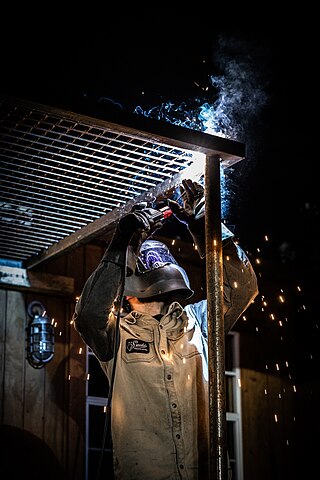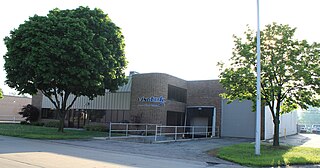
Welding is a fabrication process that joins materials, usually metals or thermoplastics, primarily by using high temperature to melt the parts together and allow them to cool, causing fusion. Common alternative methods include solvent welding using chemicals to melt materials being bonded without heat, and solid-state welding processes which bond without melting, such as pressure, cold welding, and diffusion bonding.

Spot welding is a type of electric resistance welding used to weld various sheet metal products, through a process in which contacting metal surface points are joined by the heat obtained from resistance to electric current.

Surface-mount technology (SMT), originally called planar mounting, is a method in which the electrical components are mounted directly onto the surface of a printed circuit board (PCB). An electrical component mounted in this manner is referred to as a surface-mount device (SMD). In industry, this approach has largely replaced the through-hole technology construction method of fitting components, in large part because SMT allows for increased manufacturing automation which reduces cost and improves quality. It also allows for more components to fit on a given area of substrate. Both technologies can be used on the same board, with the through-hole technology often used for components not suitable for surface mounting such as large transformers and heat-sinked power semiconductors.

Flip chip, also known as controlled collapse chip connection or its abbreviation, C4, is a method for interconnecting dies such as semiconductor devices, IC chips, integrated passive devices and microelectromechanical systems (MEMS), to external circuitry with solder bumps that have been deposited onto the chip pads. The technique was developed by General Electric's Light Military Electronics Department, Utica, New York. The solder bumps are deposited on the chip pads on the top side of the wafer during the final wafer processing step. In order to mount the chip to external circuitry, it is flipped over so that its top side faces down, and aligned so that its pads align with matching pads on the external circuit, and then the solder is reflowed to complete the interconnect. This is in contrast to wire bonding, in which the chip is mounted upright and fine wires are welded onto the chip pads and lead frame contacts to interconnect the chip pads to external circuitry.
Electric resistance welding (ERW) is a welding process in which metal parts in contact are permanently joined by heating them with an electric current, melting the metal at the joint. Electric resistance welding is widely used, for example, in manufacture of steel pipe and in assembly of bodies for automobiles. The electric current can be supplied to electrodes that also apply clamping pressure, or may be induced by an external magnetic field. The electric resistance welding process can be further classified by the geometry of the weld and the method of applying pressure to the joint: spot welding, seam welding, flash welding, projection welding, for example. Some factors influencing heat or welding temperatures are the proportions of the workpieces, the metal coating or the lack of coating, the electrode materials, electrode geometry, electrode pressing force, electric current and length of welding time. Small pools of molten metal are formed at the point of most electrical resistance as an electric current is passed through the metal. In general, resistance welding methods are efficient and cause little pollution, but their applications are limited to relatively thin materials.

Robot welding is the use of mechanized programmable tools (robots), which completely automate a welding process by both performing the weld and handling the part. Processes such as gas metal arc welding, while often automated, are not necessarily equivalent to robot welding, since a human operator sometimes prepares the materials to be welded. Robot welding is commonly used for resistance spot welding and arc welding in high production applications, such as the automotive industry.
KUKA is a German manufacturer of industrial robots and factory automation systems. In 2016, the company was acquired by Chinese appliance manufacturer Midea Group.
Welder certification, is a process which examines and documents a welder's capability to create welds of acceptable quality following a well defined welding procedure.

Selective soldering is the process of selectively soldering components to printed circuit boards and molded modules that could be damaged by the heat of a reflow oven or wave soldering in a traditional surface-mount technology (SMT) or through-hole technology assembly processes. This usually follows an SMT oven reflow process; parts to be selectively soldered are usually surrounded by parts that have been previously soldered in a surface-mount reflow process, and the selective-solder process must be sufficiently precise to avoid damaging them.
Automated optical inspection (AOI) is an automated visual inspection of printed circuit board (PCB) manufacture where a camera autonomously scans the device under test for both catastrophic failure and quality defects. It is commonly used in the manufacturing process because it is a non-contact test method. It is implemented at many stages through the manufacturing process including bare board inspection, solder paste inspection (SPI), pre-reflow and post-re-flow as well as other stages.
Weld quality assurance is the use of technological methods and actions to test or assure the quality of welds, and secondarily to confirm the presence, location and coverage of welds. In manufacturing, welds are used to join two or more metal surfaces. Because these connections may encounter loads and fatigue during product lifetime, there is a chance they may fail if not created to proper specification.
Amada Co,. Ltd. is a large Japanese manufacturer of metal processing equipment & machinery based in Kanagawa. The company is headed by Mitsuo Okamoto. The company manufactures metal cutting, forming, shearing, and punching machines. The Company also develops factory automation systems and electronic equipment in addition to machine tools. Amada's products are used in fields such as the auto, computer, camera, and electric appliance industries.

A thermal profile is a complex set of time-temperature data typically associated with the measurement of thermal temperatures in an oven. The thermal profile is often measured along a variety of dimensions such as slope, soak, time above liquidus (TAL), and peak.

Visotek Inc. is an American company, located in Livonia, Michigan, that designs, develops and manufactures individual fiber coupled diode laser modules, complete turn-key systems and peripheral components used in industrial, military, medical and research applications. Visotek also provides high volume laser processing services and is a Tier Two supplier to the automotive industry, manufacturing up to a half million pieces annually.

Ador Welding Limited is an industrial manufacturing company headquartered in Mumbai, India. The flagship company of the Ador Group, Ador Welding produces a variety of welding products, industry applications, and technology services, including welding consumables as well as welding and cutting equipment. It has over 30% market share in the organized welding market and is considered one of the major players in the Indian welding industry. Ador PEB is the company's project engineering division. PEB is based in Pune and has provided services to the Indian Government's Bharat Nirman Program in the field of combustion and thermal engineering technologies.

The European Federation for Welding, Joining and Cutting (EWF) is an organization dedicated to education, training, qualification and certification in the field of welding and related technologies.

The TRUMPF Group is a German industrial machine manufacturing company. It is a family-owned company with its head office in Ditzingen near Stuttgart. TRUMPF is one of the world's biggest providers of machine tools. With more than 70 operative subsidiaries, the TRUMPF Group is represented in all important markets worldwide. Its production facilities are based in China, Germany, France, the UK, Italy, Japan, Mexico, Austria, Poland, Switzerland, the Czech Republic and the US.

Laser beam machining (LBM) is a form of machining that uses heat directed from a laser beam. This process uses thermal energy to remove material from metallic or nonmetallic surfaces. The high frequency of monochromatic light will fall on the surface, thus heating, melting and vaporizing the material due to the impinge of photons . Laser beam machining is best suited for brittle materials with low conductivity, but can be used on most materials.











